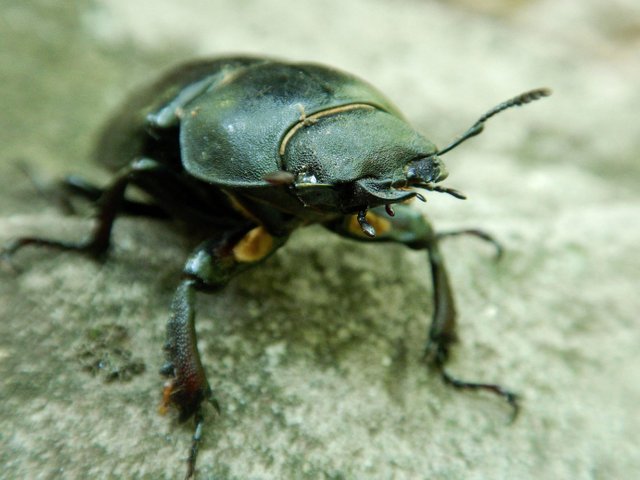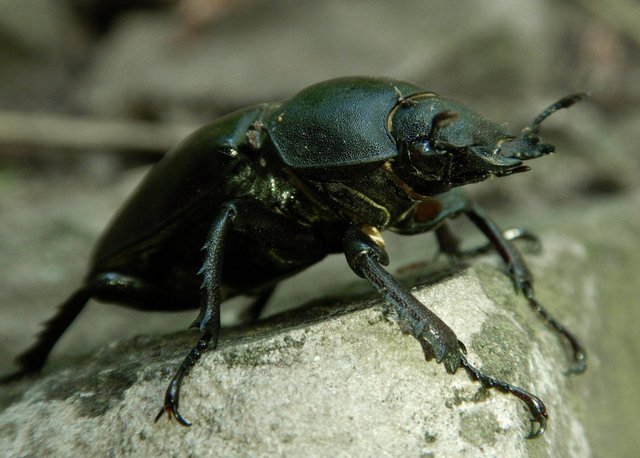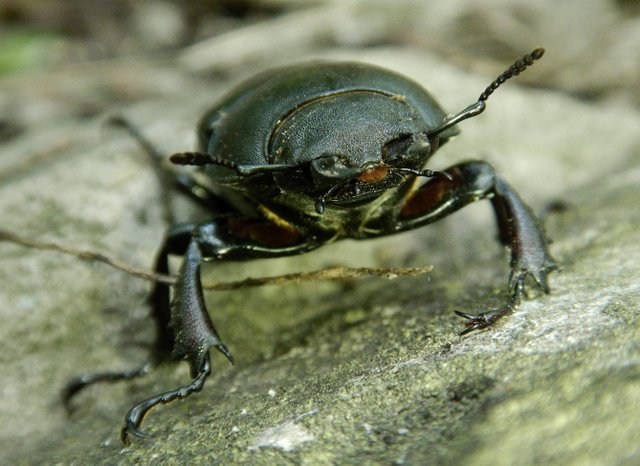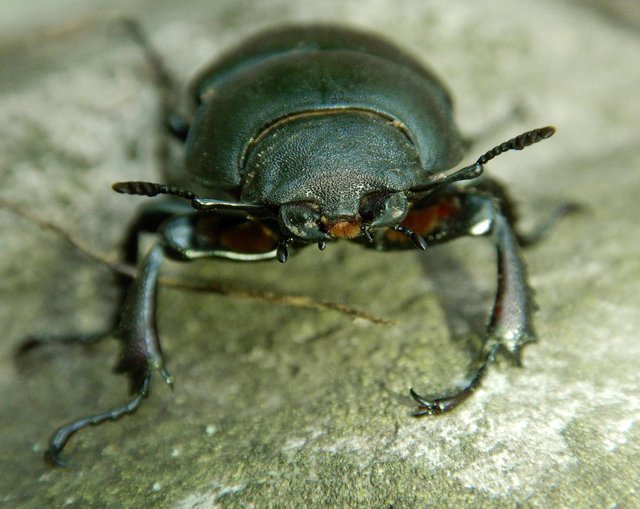⏿ Oryctes rhinoceros (coconut rhinoceros beetle)
Hi dear Steemians and other community members!
Today I want to show you a photo of a rhinoceros beetle, which I met on a recent walk...

As you can see from the absence of a large horn - it's a female!
Total body length 40.0–60.0 mm (1.57–2.36 in). Body shape elongate, slightly cylindrical. Color dark brown to black. Ocular canthus not produced. Head of male with long, slightly curved horn ending in single point; female with horn present but usually reduced. Pronotum of both sexes without horns, but with broad, sculpted depression. Pygidium of female with dense red-brown setae, setae much more sparse in male.

Regardless of the beauty and perfection of this creation, it is a malicious pest of crops.
>Oryctes rhinoceros is a severe and known biosecurity threat with a history of invasive spread. Damage is caused when young adults bore into the crowns of host plants, burrowing as deep as 50 cm into the host tissue (Molet, 2013). This often results in destruction of unopened leaves and damage of the leaf midrib (Molet, 2013). After feeding on the juices produced by damaged host tissue, the beetle bores out of the host, often through the base of the frond (Molet, 2013). Plants, particularly young plants, can be killed when the scarab damages the apical meristem or via secondary infection in the feeding burrow (Hinckley, 1973). In Palau, Gressitt (1953) attributed coconut palm mortality rates of 50% to damage caused by this beetle. Even when coconut palms are not killed in this manner, fruit production is adversely impacted. Estimates of fruit set reduction range from 5 to 25% (Bedford, 2015). Larvae of this species are not reported as pests.
Curbing the coconut rhinoceros beetle in the Pacific

Adult females deposit eggs inside dead palms, decaying plant material, soil with high organic matter content, and, occasionally, wooden structures (Manjeri et al. 2014). In approximately 11 days, eggs hatch into larvae which begin feeding on surrounding organic material. Eleven to 15 weeks later, the larvae will have grown up to 16 times larger and have stopped eating, after which they enter the pupal stage and are immobile for approximately six weeks (Hickley 1973). Upon emerging, adults fly to a new tree, feed, and mate, sometimes mating just after their first feeding. Adults spend most of their time feeding on fresh leaves. Adult females live up to nine months, over which period they can lay up to 100 eggs. Thus adult progeny may be present with the mother and the population consists of overlapping generations (Manjeri et al. 2014).
Multiple overlapping generations are common under favorable conditions, e.g. when no diapause is needed. Since coconuts occur in regions where there is no cold season and a minimal dry season, the beetles can be active and reproductive throughout the year.

Native range - Southeastern Asia. This species has a wide distribution across tropical and subtropical southeastern Asia, ranging from India and Pakistan, through Indochina, east to Okinawa, the Philippines, and Indonesia. The species has spread widely beyond its native range and can now be found in the Bismarck Archipelago, Palau, Reunion, Samoa, Tonga, Fiji, Micronesia, Mauritius, Guam, and Hawaii .

This species has been intercepted in quarantine on multiple occasions, with at least five U.S. interceptions known (Molet, 2013). Adults have been recorded on coconut "materials", military equipment and air cargo, and in potted plants (Molet, 2013; Bedford, 2015). It has been reported that larvae are able to survive in floating logs in the ocean (Molet, 2013). The distribution of the species correlates with its primary host, the coconut palm. As such, it should be regarded as a serious potential threat to territories where coconut palms occur: Florida, Puerto Rico, and the U.S. Virgin Islands. Because Oryctes rhinoceros also damages other palms, it should also be regarded as a potential threat to states such as California, Arizona, Texas, Louisiana, Mississippi, Alabama, Georgia, and the Carolinas.
Prevent the spread of this USDA regulated pest by reporting your observation at iNaturalist project.
Camera NikonW300
Ukraine 2019

Discovering exceptional content!

These photos are quite impressive @dimarss
I am quite drawn to this kind of photography (except when they are of spiders though).
Thank you for all the info you took the time and care to share here with us. An invasion of this creature must be quite a frightening sight! Especially after learning how destructive they can be and how resilient they are! 😳
Hi @abigail-dantes!
I did not know how harmful this bug is in some regions! We do not grow palm trees, and this creation is not a pest in Ukraine))
For me it was a surprise how much inconvenience this can give to farmers.
Thanks for stopping by my posts.
Nice. Even though I don't care about such insects, you have summed up a nice amount of details in the description too.
Thank's for watching!
woooow amazing
STEM rewards have been removed from this content.
This post has been voted on by the SteemSTEM curation team and voting trail. It is elligible for support from @curie.
If you appreciate the work we are doing, then consider supporting our witness stem.witness. Additional witness support to the curie witness would be appreciated as well.
For additional information please join us on the SteemSTEM discord and to get to know the rest of the community!
Please consider setting @steemstem as a beneficiary to your post to get a stronger support.
Please consider using the steemstem.io app to get a stronger support.
Don't abuse the JAHM tag .
Du erhieltest aufgrund deiner LanaCharleenToken ein Upvote von @sebescen81 und von @lanacharleen
Vielen lieben Dank für euren Support. Der Account meiner Tochter wächst und gedeiht.
Okay, @puncakbukit reblogged to thousand followers.. Many thanks to choose @puncakbukit as your witness.
Hello @dimarss, thank you for sharing this creative work! We just stopped by to say that you've been upvoted by the @creativecrypto magazine. The Creative Crypto is all about art on the blockchain and learning from creatives like you. Looking forward to crossing paths again soon. Steem on!